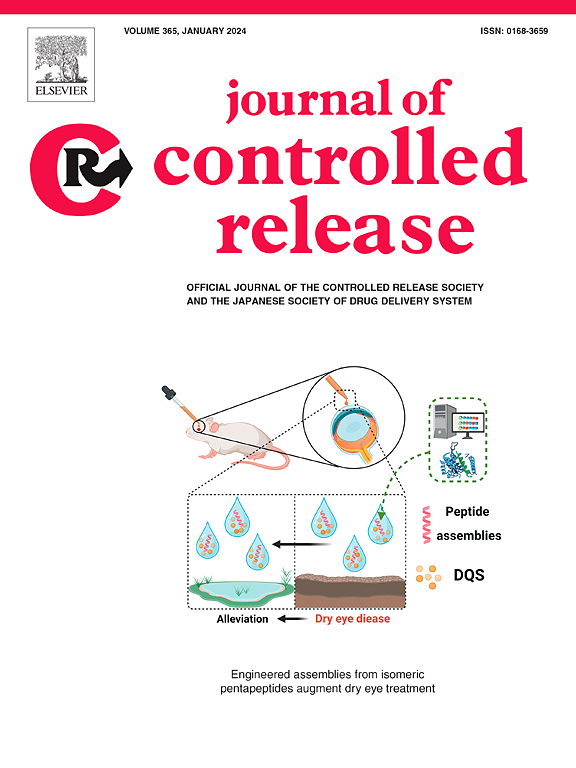抗cd33抗体增强阿糖胞苷和柔红霉素在靶向联合化疗中的脂质体共递送
IF 10.5
1区 医学
Q1 CHEMISTRY, MULTIDISCIPLINARY
引用次数: 0
摘要
阿糖胞苷和柔红霉素联合化疗(7 + 3标准方案)是几十年来治疗急性髓性白血病的主要方法。纳米医学的最新进展导致了Vyxeos®的发展,这是一种阿糖胞苷/柔红霉素的脂质体制剂,以5:1 M的协同比例固定。与传统的7 + 3方案相比,Vyxeos®化疗药物的同步药代动力学和生物分布有助于显着提高完全缓解率。然而,Vyxeos®并没有显著提高安全性,表现出相似的不良事件类型和严重程度。为了减轻不良反应并加强7 + 3联合化疗,我们利用功能化策略,设计一种人源抗cd33抗体修饰的脂质体载体,积极地共同递送阿糖胞苷和柔红霉素。与Vyxeos®的dsc / dspg脂质体制剂不同,我们开发了具有高胆固醇含量的聚乙二醇化HSPC脂质体,以按比例共载两种药物。通过马来酰亚胺-硫醇化学的表面反应实现了抗cd33抗体功能化,与普通脂质体药物制剂相比,显示出优越的体内治疗效果(p <; 0.001),并适度减少了心脏和肾脏的非特异性不良反应。本文章由计算机程序翻译,如有差异,请以英文原文为准。

Anti-CD33 antibody enhances liposomal co-delivery of cytarabine and daunorubicin for targeted combination chemotherapy
The combination chemotherapy of cytarabine and daunorubicin (7 + 3 standard regimen) has stood as the mainstay treatment against acute myeloid leukemia for decades. Recent advances in nanomedicine have led to the development of Vyxeos®, a liposomal formulation of cytarabine/daunorubicin fixed in a synergistic 5:1 molar ratio. The synchronized pharmacokinetics and biodistribution of the partner chemotherapeutic agents in Vyxeos® contribute to a significantly higher complete remission rate compared to the traditional 7 + 3 regimen. However, Vyxeos® did not markedly enhance the safety profile, exhibiting similar types and severities of adverse events. To mitigate adverse reactions as well as intensify 7 + 3 combination chemotherapy, we leveraged a functionalization strategy, engineering a humanized anti-CD33 antibody-modified liposome carrier to actively co-deliver cytarabine and daunorubicin. Differing from DSPC/DSPG-based liposomal formulation of Vyxeos®, we developed a PEGylated HSPC liposome with high cholesterol content to proportionally co-load the two agents. Surface reaction via maleimide-thiol chemistry realized anti-CD33 antibody functionalization, demonstrating superior in-vivo therapeutic efficacy compared to plain liposomal drug formulations (p < 0.001) and moderately reduced non-specific adverse effects in the heart and kidneys.
求助全文
通过发布文献求助,成功后即可免费获取论文全文。
去求助
来源期刊

Journal of Controlled Release
医学-化学综合
CiteScore
18.50
自引率
5.60%
发文量
700
审稿时长
39 days
期刊介绍:
The Journal of Controlled Release (JCR) proudly serves as the Official Journal of the Controlled Release Society and the Japan Society of Drug Delivery System.
Dedicated to the broad field of delivery science and technology, JCR publishes high-quality research articles covering drug delivery systems and all facets of formulations. This includes the physicochemical and biological properties of drugs, design and characterization of dosage forms, release mechanisms, in vivo testing, and formulation research and development across pharmaceutical, diagnostic, agricultural, environmental, cosmetic, and food industries.
Priority is given to manuscripts that contribute to the fundamental understanding of principles or demonstrate the advantages of novel technologies in terms of safety and efficacy over current clinical standards. JCR strives to be a leading platform for advancements in delivery science and technology.
 求助内容:
求助内容: 应助结果提醒方式:
应助结果提醒方式:


